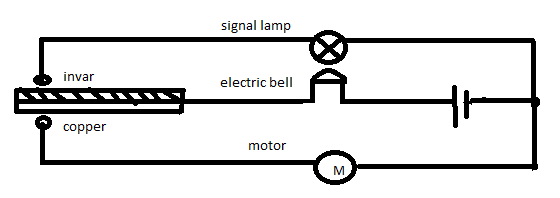
The diagram shows a bimetallic strip used as a thermostat in a circuit. The copper expands more than the invar for the same temperature rise. What will be switched on when the bimetallic strip becomes hot?

A. Bell only
B. Lamp and bell only
C. Motor and bell only
D. Lamp, bell and motor

Answer
572.1k+ views
Hint: First here we have to see what bimetallic strips are. A bimetallic strip consists of two distinct materials with different coefficient of expansion which are joined together. The resulting curvature transition or bending is an indispensible characteristic of all thermostatic bimetals in response to temperature transition.
Complete step by step solution:
A bimetal consists of two or more composite materials with various linear thermal expansion coefficients bonded by welding or riveting. The substance with the greater thermal expansion coefficient is classified as the active component and the passive component is that of the lower CTE. Alloys containing iron, manganese, nickel or chromium in different coefficients are typically found in the active portion. Invar an iron-nickel alloy is mostly preferred on the passive side.
Some bimetals have a third layer of copper between the active and passive sides to improve the thermal conductivity and reduce the electrical resistivity of the materials.
Thus as copper stretches rather than invar, the side of copper converges and the side of invar diverges such that bimetallic strips bend upward and upward circuit is short and therefore bell and lamp will turn on.
Hence, option B is correct.
Note: The working of bimetal can be briefly explained as – In a bimetallic strip the multiple expansions compel the flat surface, if warm to bend one way and vice versa. When the strip is warm, the metal with the high thermal expansion coefficient is on the outer side of the curve and on the inner side when cooled. Also owing to the high coefficient of linear expansion of copper, heating copper bends more than invar.
Complete step by step solution:
A bimetal consists of two or more composite materials with various linear thermal expansion coefficients bonded by welding or riveting. The substance with the greater thermal expansion coefficient is classified as the active component and the passive component is that of the lower CTE. Alloys containing iron, manganese, nickel or chromium in different coefficients are typically found in the active portion. Invar an iron-nickel alloy is mostly preferred on the passive side.
Some bimetals have a third layer of copper between the active and passive sides to improve the thermal conductivity and reduce the electrical resistivity of the materials.
Thus as copper stretches rather than invar, the side of copper converges and the side of invar diverges such that bimetallic strips bend upward and upward circuit is short and therefore bell and lamp will turn on.
Hence, option B is correct.
Note: The working of bimetal can be briefly explained as – In a bimetallic strip the multiple expansions compel the flat surface, if warm to bend one way and vice versa. When the strip is warm, the metal with the high thermal expansion coefficient is on the outer side of the curve and on the inner side when cooled. Also owing to the high coefficient of linear expansion of copper, heating copper bends more than invar.
Recently Updated Pages
Why are manures considered better than fertilizers class 11 biology CBSE

Find the coordinates of the midpoint of the line segment class 11 maths CBSE

Distinguish between static friction limiting friction class 11 physics CBSE

The Chairman of the constituent Assembly was A Jawaharlal class 11 social science CBSE

The first National Commission on Labour NCL submitted class 11 social science CBSE

Number of all subshell of n + l 7 is A 4 B 5 C 6 D class 11 chemistry CBSE

Trending doubts
10 examples of friction in our daily life

One Metric ton is equal to kg A 10000 B 1000 C 100 class 11 physics CBSE

Difference Between Prokaryotic Cells and Eukaryotic Cells

1 Quintal is equal to a 110 kg b 10 kg c 100kg d 1000 class 11 physics CBSE

State the laws of reflection of light

Explain zero factorial class 11 maths CBSE




